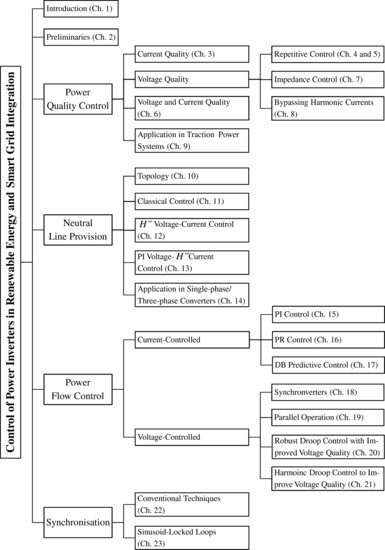1
Introduction
In this chapter, an overview of the book is given at first, followed by some basics about power processing and some hardware issues relevant to the design of power inverters. Moreover, wind power systems, solar power systems and smart grid integration are briefly described to set the scene for the rest of the book.
1.1 Outline of the Book
After making an introduction in this chapter and presenting preliminaries in Chapter 2, the book is divided into four Parts: Power Quality Control (Chapters 3–9), Neutral Line Provision (Chapters 10–14), Power Flow Control (Chapters 15–21) and Synchronisation (Chapters 22–23). The overall structure of the book is shown in Figure 1.1. Some chapters are related to more than one part, which is not shown in Figure 1.1 but will be mentioned below.
Figure 1.1 Structure of the book

Part I is devoted to the power quality issues of the current fed into the grid and the output voltage of an inverter. A current controller is designed in Chapter 3 with the H∞ repetitive control strategy so that the current injected into the grid is clean. This chapter is also directly linked to Part III under the category of current-controlled strategies. Several control strategies are presented in Chapters 4–8 to address voltage quality issues based on different mechanisms. In Chapters 4 and 5, the controllers are designed based on the H∞ repetitive control ...
Get Control of Power Inverters in Renewable Energy and Smart Grid Integration now with the O’Reilly learning platform.
O’Reilly members experience books, live events, courses curated by job role, and more from O’Reilly and nearly 200 top publishers.

